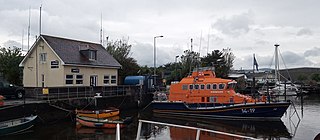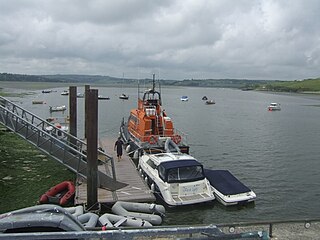Since its inception, the Royal National Lifeboat Institution (RNLI) has provided lifeboats to lifeboat stations in the United Kingdom and Ireland.

Barry Dock Lifeboat Station is located at the Pierhead Buildings, at Barry Dock Outer Harbour, near the town of Barry, in the Vale of Glamorgan, Wales.

The McLachlan-class lifeboat was an A-class lifeboat operated by the Royal National Lifeboat Institution (RNLI) of the United Kingdom and Ireland from 1967 to 1988. It was replaced by the B-class.

Hayling Island Lifeboat Station is located on the eastern side of Hayling Island, Hampshire, opposite the village of West Wittering, at the entrance to Chichester Harbour, where it joins the major shipping route of the Solent. This major shipping route is busy at all times of the year and there are estimated to be 10,000 boats in the Chichester area alone.

Littlehampton Lifeboat Station is located in the town of Littlehampton, in West Sussex, on the south coast of England.The station is on the harbour side on the eastern bank of the River Arun, a quarter mile from the harbour entrance and the pier. The current lifeboat house on Fisherman's Quay was built in 2002.

Brighton Lifeboat Station is located in the seaside town of Brighton in the county of East Sussex.

Eyemouth Lifeboat Station is located at the harbour town of Eyemouth, in the Scottish Borders, Scotland.
The Surf-class was a light non self-righting displacement hull motor lifeboat built between 1935 and 1940 and operated by the Royal National Lifeboat Institution (RNLI) between 1936 and 1965.

Aberystwyth Lifeboat Station is located at South Marine Terrace, in the coastal resort of Aberystwyth, Ceredigion, which sits on Cardigan Bay, on the west coast of Wales.

Tighnabruaich Lifeboat Station is located at the harbour at Tighnabruaich, a village on the Cowal peninsula, on the Kyles of Bute, in Argyll and Bute, Scotland.

Barmouth Lifeboat Station is located in Barmouth, a town at the mouth of the Afon Mawddach river in Gwynedd, Wales. A lifeboat was first stationed here by the Royal National Institute for the Preservation of Life from Shipwreck (RNIPLS) in 1828.

Arklow Lifeboat Station is located at South Quay in Arklow, County Wicklow, a harbour town at the mouth of the River Avoca, on the east coast of Ireland.

Wicklow Lifeboat Station is located at East Pier in the county town of Wicklow, County Wicklow, a harbour town at the mouth of the River Vartry, on the east coast of Ireland.

Courtmacsherry Harbour Lifeboat Station is located on Sea Road, in the village of Courtmacsherry, County Cork, on the southern shore of the Argideen River estuary, approximately 45 kilometres (28 mi) south west of Cork, on the south coast of Ireland.

Runswick Bay Rescue Boat operates out of the former RNLI Tractor shed, and is located in the village of Runswick Bay, in the county of North Yorkshire, in England.
Alderney Lifeboat Station is located at Braye Harbour, on the island of Alderney, the northernmost of the inhabited Channel Islands. It is part of the Bailiwick of Guernsey, a British Crown dependency.
Youghal Lifeboat Station is located on The Mall, in Youghal, a town situated on the western bank of the River Blackwater estuary in County Cork, approximately 48.5 kilometres (30.1 mi) east of the city of Cork, on the south coast of Ireland.

Skerries Lifeboat Station is situated at Harbour Road, on Red Island, a tied island at Skerries, County Dublin, a town approximately 31 kilometres (19 mi) north of Dublin in the administrative region of Fingal, on the east coast of Ireland.

Howth Lifeboat Station sits on the middle pier at Howth Harbour in the fishing village of Howth, on Howth Head, a peninsula located on the north side of Dublin Bay, in the administrative region of Fingal, historically County Dublin, on the east coast of Ireland.

Poolbeg Lifeboat Station was located near Pigeon House Fort, on the artificial peninsula of Poolbeg, reclaimed land which extends out from Ringsend, Dublin, into Dublin Bay, in the administrative region of Fingal, historically County Dublin, on the east coast of Ireland.

















